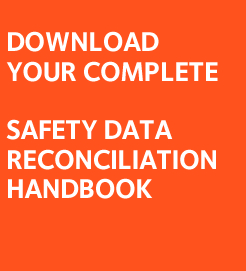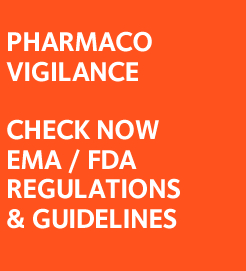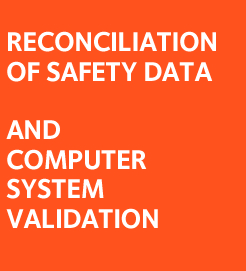Adverse drug reaction (ADR)
- During pre-approval clinical experience: all noxious and unintended responses to a medicinal product related to any dose.
- For marketed medicinal products: a response to a drug which is noxious and unintended and which occurs at doses normally used in man for prophylaxis, diagnosis, or therapy of disease or for modification of physiological function.
(source: ICH)
Adverse event (AE)
Any untoward medical occurrence in a patient or clinical investigation subject administered a pharmaceutical product and which does not necessarily have to have a causal relationship with this treatment.
(source: ICH)
Adverse event of special interest (AESI)
Adverse events defined by the sponsor as being of special interest in the framework of a given clinical study. These are defined in the Statistical Analysis Plan (SAP) and are usually reported separately and a dedicated narrative is presented in the Clinical Study Report (CSR) alongside the Serious Adverse Events narratives.
Case Record/Report Form (CRF)
A printed, optical, or electronic document (eCRF) designed to record data on each trial participant during the course of the trial as defined by the protocol. The data should be collected by procedures, which guarantee preservation, retention and retrieval of information and allow easy access for verification, audit and inspection.
Clinical Data Management System (CDMS)
The system used in a clinical trial to manage the data.
Contract Research Organization (CRO)
A person or an organization (commercial, academic or other) contracted by the sponsor to perform one or more of a sponsor’s trial-related duties and functions.
Clinical Study Report (CSR)
A written description of a trial/study of any therapeutic, prophylactic or diagnostic agent conducted in human subjects in which the clinical and statistical description, presentations, and analyses are fully integrated in a single report.
Data Correction Request Form (DCRF) or data clarification form (DCF)
The official communication form using a standard query text to the investigative site for clarification of an SAE data variable and to document any changes to data already captured in the clinical database.
Data Management Plan (DMP)
A document describing the process that will be followed for the processing and management of clinical data during a clinical study.
Ethical eReconciliation ®
A GxP-compliant and validated software designed to manage all reconciliation operations easily and efficiently. eReconciliation® allows safety and data managers not only to save time but also improve safety data quality and validate pharmacovigilance data.
See also eReconciliation Software Features and Benefit.
IT
Information Technology (usually means the IT department).
MedDRA
Medical Dictionary for Regulatory Activities (MedDRA) coding data into a standardized international medical terminology to facilitate its analysis.
Query
Question sent to an investigative site to clarify an SAE data variable. A query is managed using a DCF.
Safety database
The database used by safety groups to process and manage SAE data from clinical trials and marketed products. SAE reports (or “cases”) entered in the safety database are updated as follow-up information becomes available. Examples of safety databases include: ARGUS, ARIS-G, AERS, SAFIRE.
Clinical database
The database used by clinical teams to collect and file clinical data during the life of a clinical trial, including the SAEs occurring during the clinical trial. Examples of clinical databases include: RAVE, InFORM, ORACLE CLINICAL.
Serious adverse event or reaction (SAE or SAR)
Any untoward medical occurrence that at any dose:
- results in death
- is life-threatening (i.e. the patient was at risk of death at the time of the event; it does not refer to an event which hypothetically might have caused death if it were more severe)
- requires inpatient hospitalization or prolongation of existing hospitalization
- results in persistent or significant disability/incapacity, or
- is a congenital anomaly/birth defect.
(source: ICH)
SAE data reconciliation
The process of comparing key safety data variables between the drug or device safety SAE database and the clinical database in order to identify any discrepancy, determine whether a discrepancy is acceptable or not and, if acceptable, document the discrepancy. It is an iterative process that occurs several times during the study. When to reconcile is determined by the frequency of data receipt, scheduling of safety updates and timing of interim and final reports. The objective is to reconcile all discrepancies before final clinical database lock in order to submit validated data to regulatory authorities.
For further information you can
DOWNLOAD A COPY OF THE COMPLETE SAE RECONCILIATION HANDBOOK (16 PAGES).
SAE discrepancy
A mismatch between the safety database and the clinical database identified during the reconciliation process. A discrepancy can be for example:
- An SAE present in one database but missing in the other one
- Inconsistent SAE associated data between the databases
- Missing SAE associated data in one of the databases
- Mismatched SAE preferred term
All the identified discrepancies, actions taken to address the discrepancies, and the status relevant to the action taken are recorded in the SAE manual or electronic reconciliation tool.
SAE reconciliation listing
File listing, generally in Excel format, used to review and document all discrepancies, acceptable or not, found during SAE data reconciliation.
SAE reconciliation process
The SAE reconciliation process can be summarized in the four following steps:
- Retrieve and compare data.
- Review the discrepancies.
- Resolve the discrepancies.
- Update database.
For full explanation and details regarding the SAE Data Reconciliation Process, you can
DOWNLOAD THE FREE SAE RECONCILIATION PROCESS CHECKLIST (9 PAGES) here.
This complete checklist describes in details the process, what to do and by whom; and what major difficulties to expect during the reconciliation operations.
Serious adverse event (SAE) report form
Form used to report an SAE. An SAE report form contains information such as the event onset date, date that it became serious and end date, seriousness criteria (resulted in death, was life-threatening, required hospitalization, etc.), the severity (e.g.: mild, moderate, severe), the outcome (fatal, not resolved, resolved, resolved with sequelae, resolving, unknown), suspected drug(s) information and a causality assessment. (see also SAE reporting regulations).
Suspected Unexpected Serious Adverse Reaction (SUSAR)
A serious adverse reaction (SAR) for which a reasonable causal relationship with the medicine used is suspected but not confirmed. Unexpected means not consistent with the applicable product information (e.g., Investigator's Brochure for an unapproved investigational medicinal product or package insert/summary for an approved product).
Trial Master File (TMF)
The collection of the essential documents of a trial which individually and collectively permit evaluation of the conduct of a trial and the quality of the data produced. TMSs are established at the beginning of the trial, both at the investigator’s site and at the sponsor’s office and are updated with new relevant documents as new information becomes available.
Unexpected adverse drug reaction (UAR)
An adverse reaction, the nature or severity of which is not consistent with the applicable product information (e.g., Investigator's Brochure for an unapproved investigational medicinal product or package insert/summary for an approved product).

 eReconciliation®
Download the Solution Description
DOWNLOAD
GxP Compliance
Open/Close sub menu
eReconciliation®
Download the Solution Description
DOWNLOAD
GxP Compliance
Open/Close sub menu
 eReconciliation®
Download the Solution Description
DOWNLOAD
GxP Compliance
Open/Close sub menu
eReconciliation®
Download the Solution Description
DOWNLOAD
GxP Compliance
Open/Close sub menu



